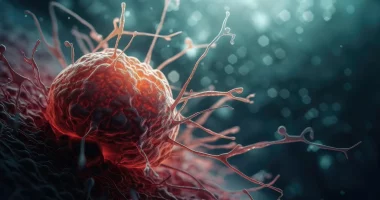Central pain syndrome is a condition that affects the central nervous system, which includes the spinal cord and brain. This disorder changes how the spinal cord and brain process pain signals, making a person much more sensitive to pain.
Here’s how it works: the brain constantly receives and processes signals from the body. In CPS, the pain receptors in the CNS become overly active. This means they send pain signals even in response to things that normally wouldn’t hurt, or they exaggerate the feeling of pain.
Individuals with CPS might experience pain all over their body, or just in particular areas. This pain is often continuous but can sometimes attack and relieve. Living with this type of chronic pain might impact a person’s energy levels, mood, and overall standard of life.
What is it?
CPS is a condition that impacts the central nervous system, which includes the spinal cord and brain. It happens when the sensory receptors in these areas don’t detect pain the way they normally should.
Under normal circumstances, pain signals alert us when something is wrong. For instance, if you touch something hot, pain signals from the skin travel to the brain, letting you know to pull away because it’s harmful.
In CPS, the CNS becomes unusually sensitive. This means it may respond strongly to things that aren’t actually harmful, like a gentle touch, or even react to no stimulus. Additionally, the brain interprets these pain signals as being much more intense than they really are.
It’s important to understand that this pain is very real. It’s not just a result of mental health issues; rather, the central nervous system is sending genuine pain signals, but for reasons that are unclear or unusual.
Symptoms
The main symptom of CPS is persistent pain that lasts for three months or even more without a clear cause. This pain is often constant but can sometimes come and go.
One of the challenges of CPS is that it can be triggered by things that usually don’t cause pain, such as a gentle touch from the wind, and clothing. In many cases, however, there is no obvious trigger for the pain.
Individuals with this condition may experience various symptoms, including continuous pain without a physical cause, sensitivity to itching, light touch, numbness, trouble sleeping, and mood swings. The intensity of these symptoms can vary widely, ranging from mild to serious.
Causes
The understanding of what causes CPS has evolved over time. Initially, it was thought to happen only after damage to the brain stem or spinal cord. However, it is now recognized that there are various potential causes.
CPS can develop when there is a dysfunction in how the central nervous system processes pain signals. This includes conditions like a brain tumor, stroke, spinal cord trauma, and multiple sclerosis.
Additionally, several risk factors can contribute to the development of CPS. These include genetic predisposition, other chronic pain conditions, persistent stress, psychological trauma, obesity, and depression.
Research suggests that the risk of getting CPS is influenced equally by genetic and environmental factors. Early childhood trauma, emotional stress, and infections are thought to contribute to almost 5 to 10% of episodes.
Diagnosis
Diagnosing CPS can be challenging because there is no certain test for the condition, and it shares similarities with other disorders. As a result, it often takes time to arrive at a diagnosis, as healthcare providers need to eliminate other possible causes.
The diagnostic process typically begins with a thorough review of the patient’s medical history. The healthcare provider will ask detailed questions about any previous surgeries, injuries, or medical issues, as well as when the pain began, its location, and its nature. They will also inquire about factors that influence the pain, like what makes it worse or better, and any additional symptoms like changes in energy levels, mood, stiffness, or weakness.
Based on this information, the healthcare provider may order various tests, including medical imaging and blood tests to help further evaluate the condition and exclude other potential explanations for the symptoms.
Treatment
CPS treatment often involves a combination of strategies, as different approaches may be effective for different individuals.
Mental Health and Lifestyle Approaches
Non-drug treatments can play a significant role in managing CPS. These include occupational therapy, physical therapy, stress management, and mental health support. These methods focus on enhancing the quality of life and improving management skills, helping individuals manage their pain and associated challenges more effectively.
Medication
For pain that’s focused on one specific part of the body, healthcare providers may recommend using pain medication like local injections, called nerve blocks. But common pain medications like opioids and ibuprofen generally do not provide relief for CPS.
Other kinds of medications may offer some relief, like:
- Amitriptyline: An antidepressant that may help decrease pain, especially when it starts in the brain.
- Mexiletine: Typically used to treat irregular heartbeats, this drug might help with CPS in cases that do not react to other interventions.
- Lamotrigine: An antiseizure drug that may also benefit those with CPS.
The Food and Drug Administration has also approved medicines like pregabalin and gabapentin for CPS. However, research on these drugs has produced mixed outcomes.
It is important to note that all medications can have side effects. Some may cause dependence or withdrawal symptoms if discontinued. Therefore, it is crucial to discuss these potential benefits and risks with a healthcare provider.
Ongoing research is exploring additional methods to manage CPS. These include hypnosis, direct current stimulation, transcranial magnetic stimulation, and various surgical techniques aimed at electrically stimulating areas of the brain or altering brain function. More researches are needed to confirm the safety and effectiveness of these emerging treatments.
Summary
Central pain syndrome is a condition where the CNS becomes overly sensitive, causing persistent pain without a clear cause. Diagnosis involves eliminating other conditions through medical history and tests. Treatment often includes a mix of lifestyle modifications, like physical therapy and stress management, and medications like lamotrigine and amitriptyline. Common painkillers are usually ineffective, and new treatments, including hypnosis and brain stimulation techniques, are under investigation. Each treatment approach has potential benefits and risks, requiring careful discussion with a healthcare provider.








